Millennial Consumer's Perceptions of CSR
Added on 2022-03-31
111 Pages25280 Words81 Views
Millennial Consumers’ Perceptions of Corporate Social Responsibility
by
Shelly Jo Smith, B.S.
A Thesis
In
RETAIL AND HOSPITALITY MANAGEMENT
Submitted to the Graduate Faculty
of Texas Tech University in
Partial Fulfillment of
the Requirements for
the Degree of
MASTER OF SCIENCE
Approved
Dr. Deborah Fowler
Committee Chair
Dr. Jungsun (Sunny) Kim
Peggy Miller
Dean of the Graduate School
May, 2012
by
Shelly Jo Smith, B.S.
A Thesis
In
RETAIL AND HOSPITALITY MANAGEMENT
Submitted to the Graduate Faculty
of Texas Tech University in
Partial Fulfillment of
the Requirements for
the Degree of
MASTER OF SCIENCE
Approved
Dr. Deborah Fowler
Committee Chair
Dr. Jungsun (Sunny) Kim
Peggy Miller
Dean of the Graduate School
May, 2012
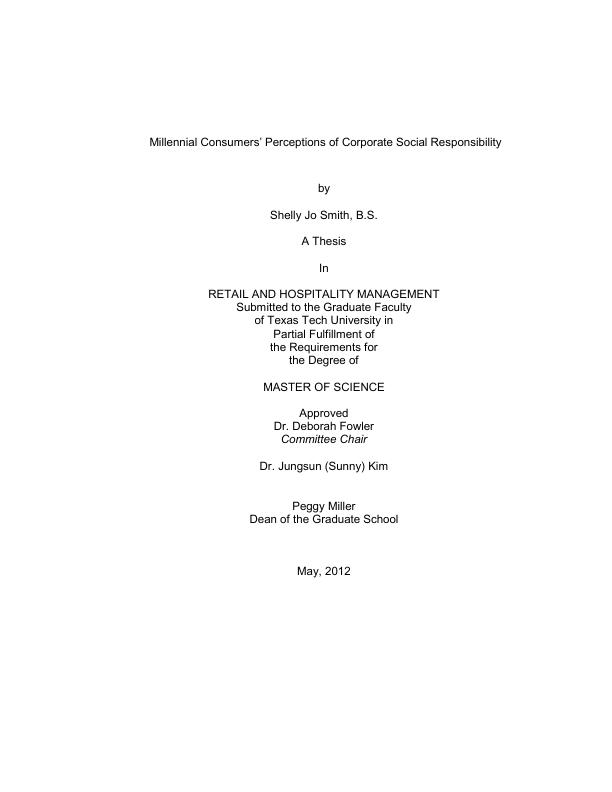
Copyright 2012, Shelly Jo Smith

Texas Tech University, Shelly Jo Smith, May 2012
ii
ACKNOWLEDGEMENTS
First, I would like to thank my parents for all they have done for me
throughout my college career. Through the support of my family, both financially and
emotionally, I have been able to achieve any life goal or academic endeavor I have
set my mind to. In all that I do, I am conscious of my parent’s example of living a life
of faith, strong work ethic, patience and perseverance.
A special thanks to my friend, coworker and fellow thesis researcher Ashley
Adams for all of the support, assistance, and laughter you conveyed throughout the
entire research process. Ashley made the thesis process a memorable and
entertaining experience. To my roommate, friend and peer Denise Sanchez, thank
you for helping me keep life light and fun when things got hectic.
I would like to thank Dan Fang and Dr. Catherine Jai for helping navigate me
through EEG collection and EEG software, the two of you were such a big help. Data
collection would not be possible without Dr. Mary Baker, Dr. Michael O’Boyle, and
the students of Autumn’s Dawn NeuroImaging, Cognition and Engineering (NICE)
lab, I appreciate you sharing your time and space.
Lastly, this thesis would not have been possible without my committee chair
Dr. Deborah Fowler and committee member Dr. Jungsun (Sunny) Kim. From my
undergraduate education throughout my graduate education and thesis research, Dr.
Fowler has always helped encourage me to be the best I can be and go the extra
mile. Dr. Fowler’s leadership, throughout my thesis, helped direct me through a
unique and challenging area of research that I never have imagined doing, let alone
doing without her direction. Dr. Fowler, I am most thankful for the spirit of
ii
ACKNOWLEDGEMENTS
First, I would like to thank my parents for all they have done for me
throughout my college career. Through the support of my family, both financially and
emotionally, I have been able to achieve any life goal or academic endeavor I have
set my mind to. In all that I do, I am conscious of my parent’s example of living a life
of faith, strong work ethic, patience and perseverance.
A special thanks to my friend, coworker and fellow thesis researcher Ashley
Adams for all of the support, assistance, and laughter you conveyed throughout the
entire research process. Ashley made the thesis process a memorable and
entertaining experience. To my roommate, friend and peer Denise Sanchez, thank
you for helping me keep life light and fun when things got hectic.
I would like to thank Dan Fang and Dr. Catherine Jai for helping navigate me
through EEG collection and EEG software, the two of you were such a big help. Data
collection would not be possible without Dr. Mary Baker, Dr. Michael O’Boyle, and
the students of Autumn’s Dawn NeuroImaging, Cognition and Engineering (NICE)
lab, I appreciate you sharing your time and space.
Lastly, this thesis would not have been possible without my committee chair
Dr. Deborah Fowler and committee member Dr. Jungsun (Sunny) Kim. From my
undergraduate education throughout my graduate education and thesis research, Dr.
Fowler has always helped encourage me to be the best I can be and go the extra
mile. Dr. Fowler’s leadership, throughout my thesis, helped direct me through a
unique and challenging area of research that I never have imagined doing, let alone
doing without her direction. Dr. Fowler, I am most thankful for the spirit of

Texas Tech University, Shelly Jo Smith, May 2012
iii
perseverance you helped reinforce in me. I will never forget the lesson you taught
me, that no matter how big or small obstacles may be they should never discourage
me from following my dreams. Dr. Kim has been an ideal collaborator to have on
Thesis committee, as she has always encouraged me to challenge myself and
provided guidance to help set me up for success. Thanks to Dr. Kim, I am reminded
that I can do anything I set my mind to with hard work and determination. To both Dr.
Fowler and Dr. Kim, you have both set such a positive examples for me as a
researcher, student, and professional and for that I am so thankful to have had this
opportunity to work with the both of you.
iii
perseverance you helped reinforce in me. I will never forget the lesson you taught
me, that no matter how big or small obstacles may be they should never discourage
me from following my dreams. Dr. Kim has been an ideal collaborator to have on
Thesis committee, as she has always encouraged me to challenge myself and
provided guidance to help set me up for success. Thanks to Dr. Kim, I am reminded
that I can do anything I set my mind to with hard work and determination. To both Dr.
Fowler and Dr. Kim, you have both set such a positive examples for me as a
researcher, student, and professional and for that I am so thankful to have had this
opportunity to work with the both of you.
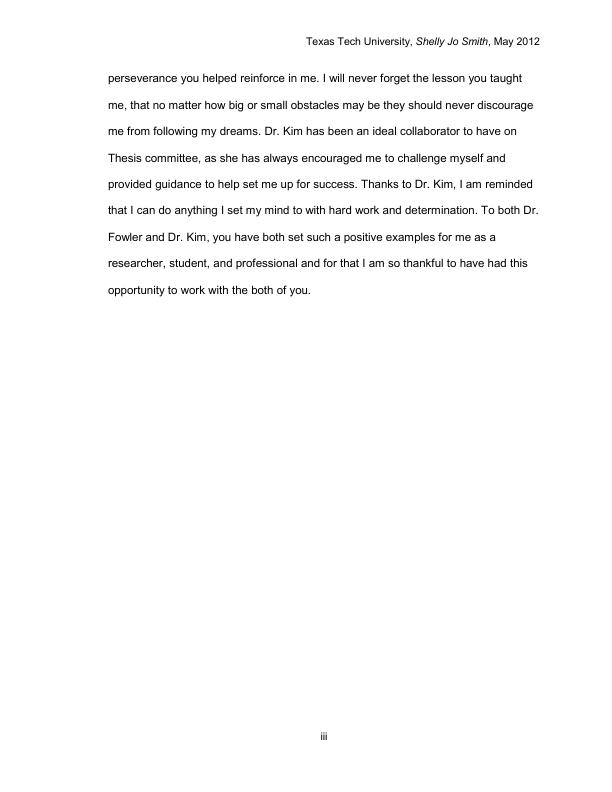
Texas Tech University, Shelly Jo Smith, May 2012
iv
TABLE OF CONTENTS
ACKNOWLEDGEMENTS................................................................................................ ii
ABSTRACT ................................................................................................................... vii
LIST OF TABLES ........................................................................................................... ix
LIST OF FIGURES .......................................................................................................... x
I. INTRODUCTION .......................................................................................................... 1
Statement of the Problem.....................................................................................2
Significance .......................................................................................................... 2
Research Objectives ............................................................................................3
Research Hypotheses ..........................................................................................3
Description of the Testing Site..............................................................................4
Limitations ............................................................................................................ 4
Data Collection ..................................................................................................... 6
Definition of Terms ...............................................................................................6
II. REVIEW OF LITERATURE .........................................................................................9
Introduction........................................................................................................... 9
Neuromarketing.................................................................................................... 9
Neuro Technologies ...........................................................................................10
MEG ........................................................................................................ 10
PET ......................................................................................................... 11
fMRI ........................................................................................................ 12
EEG ........................................................................................................ 13
Consumer Decision Making................................................................................16
Decision Drivers ......................................................................................17
Emotions and Perception ........................................................................18
Purchase Influences................................................................................19
The Human Brain: Decision Making and Shopping Preferences ........................19
Brain Matter in Males and Females .........................................................20
Male versus Female Decision Making .....................................................21
Generation Y ...........................................................................................22
Corporate Social Responsibility..........................................................................23
Commercial and Ethical Responsibilities.................................................24
Social Responsibilities.............................................................................24
Environmental Responsibilities................................................................25
Practicing Corporate Social Responsibility ......................................................... 25
Walmart................................................................................................... 26
Starbucks ................................................................................................28
Marriott .................................................................................................... 30
Corporate Societal Marketing .............................................................................31
Theoretical Framework.......................................................................................33
Summary............................................................................................................ 35
iv
TABLE OF CONTENTS
ACKNOWLEDGEMENTS................................................................................................ ii
ABSTRACT ................................................................................................................... vii
LIST OF TABLES ........................................................................................................... ix
LIST OF FIGURES .......................................................................................................... x
I. INTRODUCTION .......................................................................................................... 1
Statement of the Problem.....................................................................................2
Significance .......................................................................................................... 2
Research Objectives ............................................................................................3
Research Hypotheses ..........................................................................................3
Description of the Testing Site..............................................................................4
Limitations ............................................................................................................ 4
Data Collection ..................................................................................................... 6
Definition of Terms ...............................................................................................6
II. REVIEW OF LITERATURE .........................................................................................9
Introduction........................................................................................................... 9
Neuromarketing.................................................................................................... 9
Neuro Technologies ...........................................................................................10
MEG ........................................................................................................ 10
PET ......................................................................................................... 11
fMRI ........................................................................................................ 12
EEG ........................................................................................................ 13
Consumer Decision Making................................................................................16
Decision Drivers ......................................................................................17
Emotions and Perception ........................................................................18
Purchase Influences................................................................................19
The Human Brain: Decision Making and Shopping Preferences ........................19
Brain Matter in Males and Females .........................................................20
Male versus Female Decision Making .....................................................21
Generation Y ...........................................................................................22
Corporate Social Responsibility..........................................................................23
Commercial and Ethical Responsibilities.................................................24
Social Responsibilities.............................................................................24
Environmental Responsibilities................................................................25
Practicing Corporate Social Responsibility ......................................................... 25
Walmart................................................................................................... 26
Starbucks ................................................................................................28
Marriott .................................................................................................... 30
Corporate Societal Marketing .............................................................................31
Theoretical Framework.......................................................................................33
Summary............................................................................................................ 35
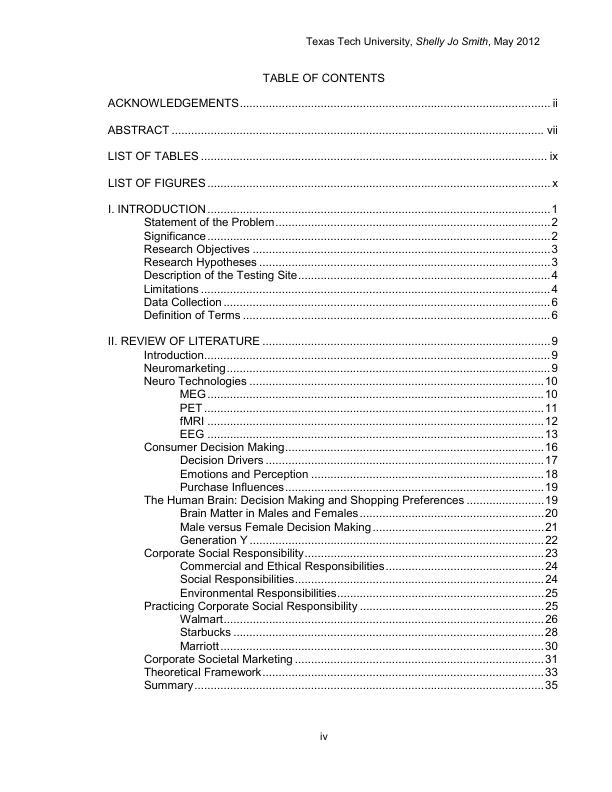
Texas Tech University, Shelly Jo Smith, May 2012
v
III. METHODS AND PROCEDURES ............................................................................. 36
Introduction......................................................................................................... 36
Research Objectives .......................................................................................... 37
Research Hypotheses ........................................................................................ 37
Method ............................................................................................................... 40
Testing Site ............................................................................................. 40
Recruitment............................................................................................. 41
Sampling Procedure ........................................................................................... 41
Survey Instruments ............................................................................................43
Initial Survey............................................................................................43
The Electroencephalography (EEG) Scan...............................................45
Post Survey............................................................................................. 48
Pilot Study .......................................................................................................... 49
Data Collection ................................................................................................... 51
Summary............................................................................................................ 55
IV. FINDINGS AND RESULTS ...................................................................................... 56
Introduction......................................................................................................... 56
Research Design ................................................................................................56
Data Analysis ..................................................................................................... 56
Research Objectives .......................................................................................... 57
Research Hypotheses and Findings...................................................................58
Research Hypothesis 1 ........................................................................... 59
Research Hypothesis 2 ........................................................................... 59
Research Hypothesis 3 ........................................................................... 61
Research Hypothesis 4 ........................................................................... 61
Research Hypothesis 5 ........................................................................... 61
Research Hypothesis 6 ...........................................................................63
Research Hypothesis 7 ........................................................................... 65
Research Hypothesis 8 ........................................................................... 66
Summary............................................................................................................ 68
V. SUMMARY AND RECOMMENDATIONS ................................................................. 69
Introduction......................................................................................................... 69
Theoretical Framework....................................................................................... 70
Research Objectives .......................................................................................... 72
Instrument .......................................................................................................... 72
Initial Survey............................................................................................72
The Electroencephalography (EEG) Scan...............................................73
Post Survey............................................................................................. 73
Measurement ..................................................................................................... 74
Research Hypotheses ........................................................................................ 74
Conclusions and Recommendations .................................................................. 77
Summary............................................................................................................ 79
REFERENCES .............................................................................................................. 80
v
III. METHODS AND PROCEDURES ............................................................................. 36
Introduction......................................................................................................... 36
Research Objectives .......................................................................................... 37
Research Hypotheses ........................................................................................ 37
Method ............................................................................................................... 40
Testing Site ............................................................................................. 40
Recruitment............................................................................................. 41
Sampling Procedure ........................................................................................... 41
Survey Instruments ............................................................................................43
Initial Survey............................................................................................43
The Electroencephalography (EEG) Scan...............................................45
Post Survey............................................................................................. 48
Pilot Study .......................................................................................................... 49
Data Collection ................................................................................................... 51
Summary............................................................................................................ 55
IV. FINDINGS AND RESULTS ...................................................................................... 56
Introduction......................................................................................................... 56
Research Design ................................................................................................56
Data Analysis ..................................................................................................... 56
Research Objectives .......................................................................................... 57
Research Hypotheses and Findings...................................................................58
Research Hypothesis 1 ........................................................................... 59
Research Hypothesis 2 ........................................................................... 59
Research Hypothesis 3 ........................................................................... 61
Research Hypothesis 4 ........................................................................... 61
Research Hypothesis 5 ........................................................................... 61
Research Hypothesis 6 ...........................................................................63
Research Hypothesis 7 ........................................................................... 65
Research Hypothesis 8 ........................................................................... 66
Summary............................................................................................................ 68
V. SUMMARY AND RECOMMENDATIONS ................................................................. 69
Introduction......................................................................................................... 69
Theoretical Framework....................................................................................... 70
Research Objectives .......................................................................................... 72
Instrument .......................................................................................................... 72
Initial Survey............................................................................................72
The Electroencephalography (EEG) Scan...............................................73
Post Survey............................................................................................. 73
Measurement ..................................................................................................... 74
Research Hypotheses ........................................................................................ 74
Conclusions and Recommendations .................................................................. 77
Summary............................................................................................................ 79
REFERENCES .............................................................................................................. 80

Texas Tech University, Shelly Jo Smith, May 2012
vi
APPENDIX
A. IRB APPROVAL ................................................................................................. 89
B. THE ORAL SCRIPT ........................................................................................... 90
C. THE WRITTEN E-MAIL SCRIPT ........................................................................ 91
D. FIRST CONSENT FORM ...................................................................................92
E. SECOND CONSENT FORM ..............................................................................93
F. INITIAL SURVEY ...............................................................................................95
G. POST SURVEY..................................................................................................98
vi
APPENDIX
A. IRB APPROVAL ................................................................................................. 89
B. THE ORAL SCRIPT ........................................................................................... 90
C. THE WRITTEN E-MAIL SCRIPT ........................................................................ 91
D. FIRST CONSENT FORM ...................................................................................92
E. SECOND CONSENT FORM ..............................................................................93
F. INITIAL SURVEY ...............................................................................................95
G. POST SURVEY..................................................................................................98
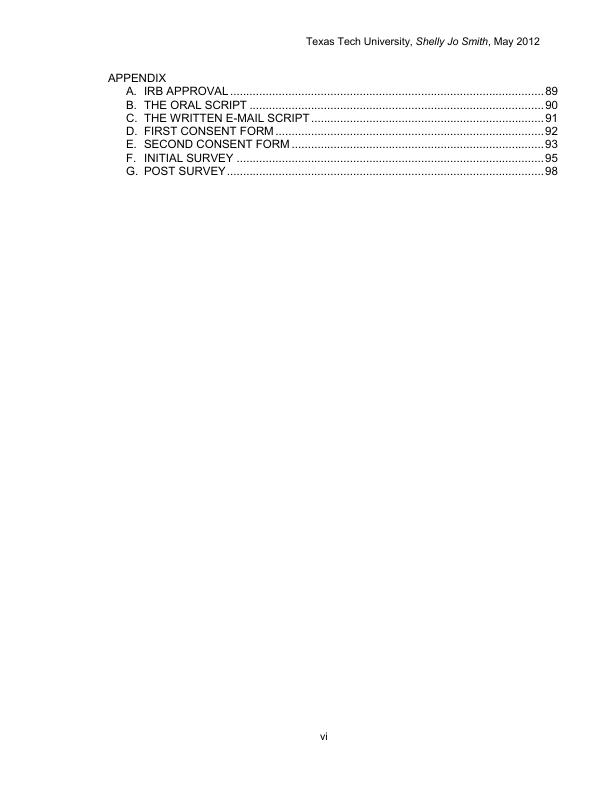
Texas Tech University, Shelly Jo Smith, May 2012
vii
ABSTRACT
The purpose of this study was to measure consumer response to Corporate
Social Responsibility (CSR). In recent years the adoption of CSR has become
popularized by many companies, however little academic or industry related data
has been collected to determine the relationship between consumer perception of
CSR with purchasing and patronage. For this study, the well-known companies of
Walmart, Starbucks, and Marriott web-sites were chosen; as these companies are
geo-graphically diverse recognizable consumer brands which all have well-
developed and award winning Corporate Social Responsibility programs. The
sample sought in this study was the web-site surfing college-aged-members of
Generation Y, a rapidly growing group of consumers whose purchasing power will
play a role in the future direction of companies (i.e., online retailing, online
marketing).
The primary data sought in this study was the subconscious response of
Generation Y when presented a web-site inspired PowerPoint containing the
Corporate Social Responsibility initiatives of all three companies. As purchasing of
goods is often a subconscious response and relies more on emotion rather than
reasoning, obtaining subconscious data is crucial to understanding the minds of
consumers. In order to test consumers’ subconscious responses, the neuroimaging
instrument of Electroencephalography (EEG) was used. The EEG scan was
conducted in NeuroImaging Cognition and Engineering Lab of within Texas Tech
University. Prior to EEG scanning, a pre-survey was administered online to gather
baseline participant responses to each of the companies and gather consumer
vii
ABSTRACT
The purpose of this study was to measure consumer response to Corporate
Social Responsibility (CSR). In recent years the adoption of CSR has become
popularized by many companies, however little academic or industry related data
has been collected to determine the relationship between consumer perception of
CSR with purchasing and patronage. For this study, the well-known companies of
Walmart, Starbucks, and Marriott web-sites were chosen; as these companies are
geo-graphically diverse recognizable consumer brands which all have well-
developed and award winning Corporate Social Responsibility programs. The
sample sought in this study was the web-site surfing college-aged-members of
Generation Y, a rapidly growing group of consumers whose purchasing power will
play a role in the future direction of companies (i.e., online retailing, online
marketing).
The primary data sought in this study was the subconscious response of
Generation Y when presented a web-site inspired PowerPoint containing the
Corporate Social Responsibility initiatives of all three companies. As purchasing of
goods is often a subconscious response and relies more on emotion rather than
reasoning, obtaining subconscious data is crucial to understanding the minds of
consumers. In order to test consumers’ subconscious responses, the neuroimaging
instrument of Electroencephalography (EEG) was used. The EEG scan was
conducted in NeuroImaging Cognition and Engineering Lab of within Texas Tech
University. Prior to EEG scanning, a pre-survey was administered online to gather
baseline participant responses to each of the companies and gather consumer
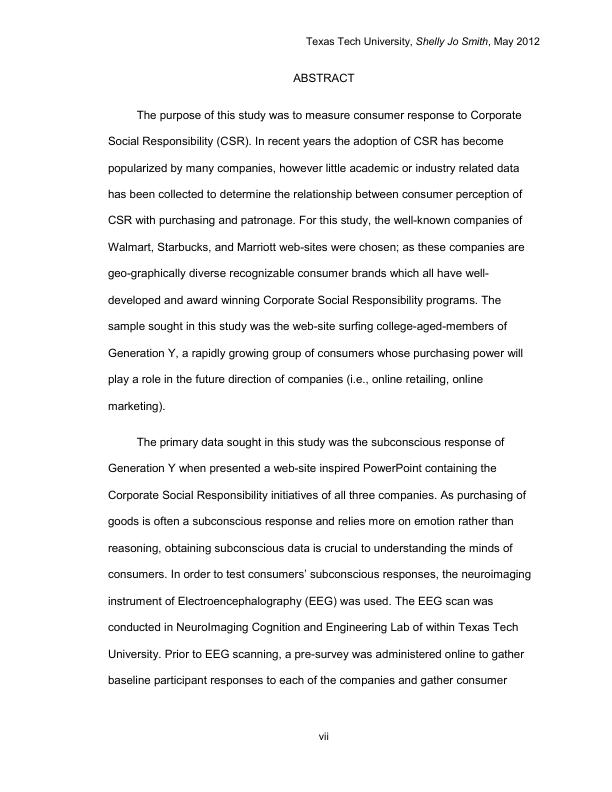
End of preview
Want to access all the pages? Upload your documents or become a member.
